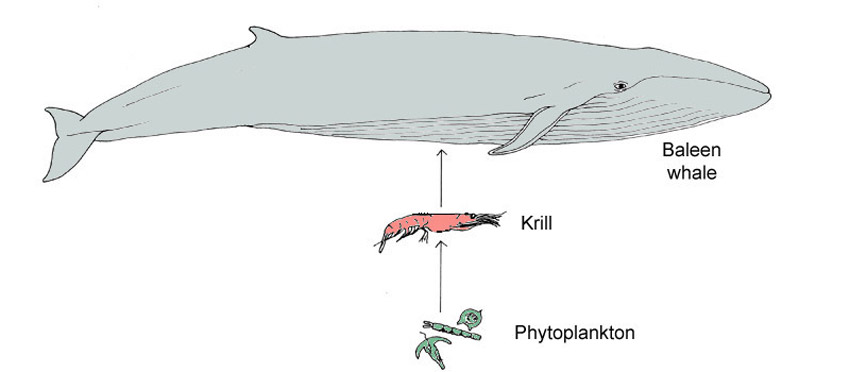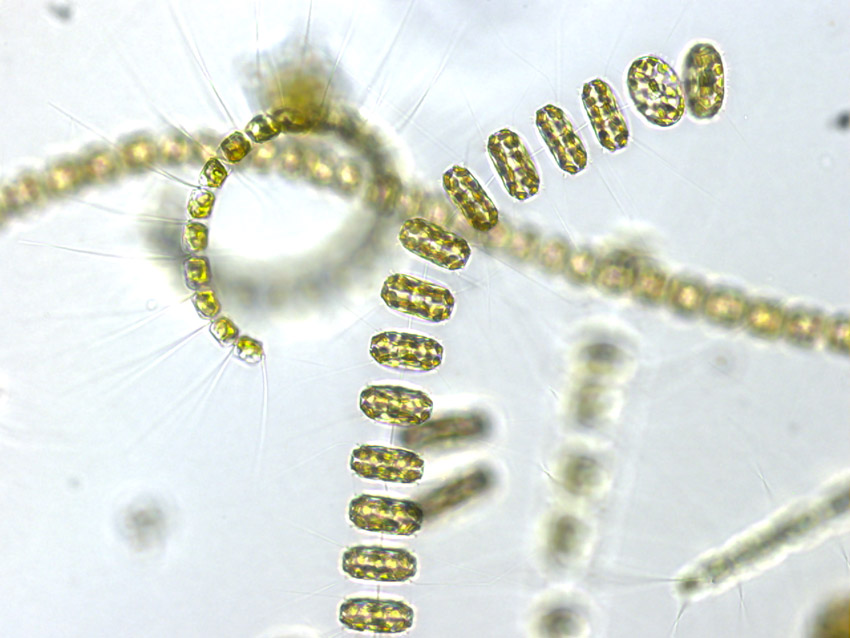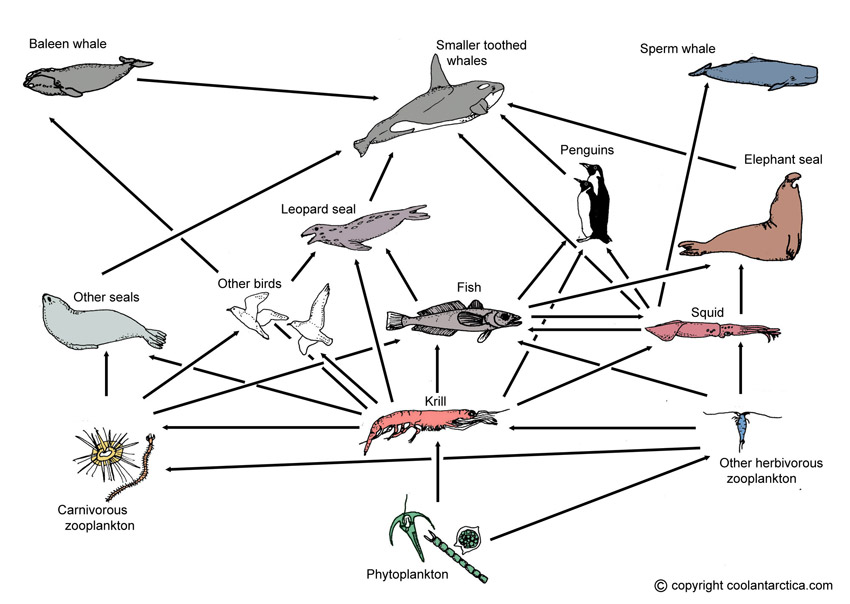Whales
Antarctica Food Chains and Food Webs
A simple Antarctic food chain is the secret to the success of the baleen whales - keep the chain short and transfer as much energy as possible as efficiently as possible.

Whales are the largest animals ever to have lived, larger even than the largest dinosaurs. There are two reasons that they have managed to attain such enormous size - well over a hundred tonnes for the largest blue whales and nearing this amount for some other whale species.
1/ They live in the oceans and so the buoyancy of the water can support their great bulk rather than having to be propped up on land by legs and muscles. As with most other mammals, the density of a whale is very close to that of water.
2/ Whales tap the food chain low down - close to the producers, there are few steps and so little energy is lost meaning more is available to the whales, so they are able to grow to enormous sizes. The higher up a food chain you get, the lower the biomass of animals (that is number of animals multiplied by their weight) because there are more steps and so more energy is lost. The more steps in a chain means less food available at the top, no more than 10% is ever passed on from one step to the next, often much less.

Antarctic Ocean Food Web
The Antarctic Food Web is relatively simple compared to ecosystems in other parts of the world. There are fewer different species, but greater numbers of individuals of each. The second most numerous large mammal in the world (after man) is the crab-eater seal, an archetypal Antarctic animal.
A key part of the Antarctic food web are krill small shrimp-like crustaceans that the great majority of Antarctic animals, seal, whales, penguins and other birds, fish etc. feed upon.
Phytoplankton - The Producers in Antarctic Food Chains
There are few land plants in Antarctica, all the large animals including the ones that come onto land like seals, penguins and other birds take their food from the sea. The producers in Antarctic food chains are tiny single celled plants known collectively as phytoplankton that float in the upper layer of the sea though they can grow at depths down to about 100m.

Assorted phytoplankton, these are about 20,000 larger than life size
There are many different species and types of phytoplankton, the two largest groups are Diatoms and Dinoflagellates, they are from 2-2000 micrometers in size, by comparison the width of a human hair is in the region of 100 micrometers.
Diatoms are made of two (di) external silica shells that fit together like a small box. Dinoflagellates have a flagellum a whip-like "tail" that they can use to move about.
Words and phrases
Food chain: A sequence of organisms starting with a producer (usually a plant), followed by the animal that eats the plant, then an animal that eats that animal and so on to the "top carnivore" an animal that eats others but is not killed and eaten by any other. Though everything eventually gets "eaten" by decomposers when it dies by some other cause. The arrows always point to the animal that does the eating and from the organism that gets eaten, more specifically they indicate the flow of energy.
Food web: A complex combination of a number of animals and plants in an ecosystem or habitat that shows what eats what and what gets eaten by what. A food web shows a more accurate picture as in reality it is rare for anything to just eat one kind of food.
Plankton: organisms that live in the top layers of a body of water, whether sea, lake, pond, river etc. Plankton are at the mercy of the currents and movement of the water. Some plankton dwellers can move about within the water column, up and down, but drift where the tides and currents take them.
Phytoplankton: Phyto- plant, Plankton - see above. These are the tiny plants that capture the energy of the sun and turn it into food, they are the Producers of the Antarctic food web. As they are so tiny, they can divide and grow very quickly in response to the more intense and longer lasting light of the summer months.
Zooplankton; Zoo - animal, Plankton - see above. These are the tiny (and not so tiny) animals that feed directly on the phytoplankton, In Antarctica they are often krill which provide the food for most of all the larger animals.
Producer: An organism that produces food. Usually a green plant, anything from microscopic algae (as in phytoplankton) to a tree. The raw materials are sunlight for energy, with carbon dioxide and water providing the main raw materials for growth. Producers drive all food webs and chains. At each step along the chain energy is lost, only 10% or often much less is passed on between steps.
Consumer: An organism that eats food in
the form of other organisms, plants, animals or a mixture
of the two. If the consumer eats plants it is called a primary
consumer as it is the first consumer in the food chain.
If it eats an animal that itself is a consumer it is a secondary
consumer as the second consumer in the food chain. In the
Antarctic food chain krill are primary consumers and baleen
whales, penguins, seals and many kinds of fish and other
birds are secondary consumers when feeding on krill. Many
animals are a mixture of primary, secondary, tertiary (3rd)
and quaternary (4th) consumers as they eat a variety of
prey.
Big floes have little floes all around about 'em
And all the yellow diatoms couldn't do without 'em.
Forty million shrimplets feed upon the latter,
And
they make the penguin and the seals and whales
...Much
fatter.
Thomas Griffith Taylor - geologist
on Scott's 1909-11 Antarctic expedition
Big fleas have little fleas,
Upon their backs
to bite 'em,
And little fleas have lesser fleas,
and so, ad infinitum.
The original nursery rhyme "Fleas".

